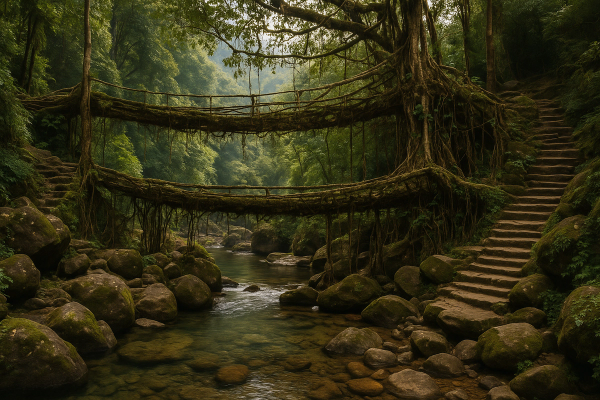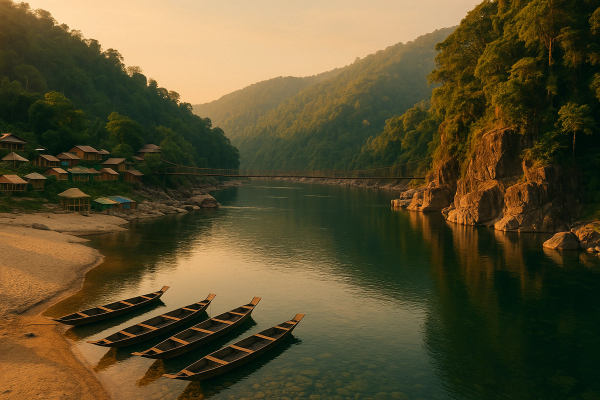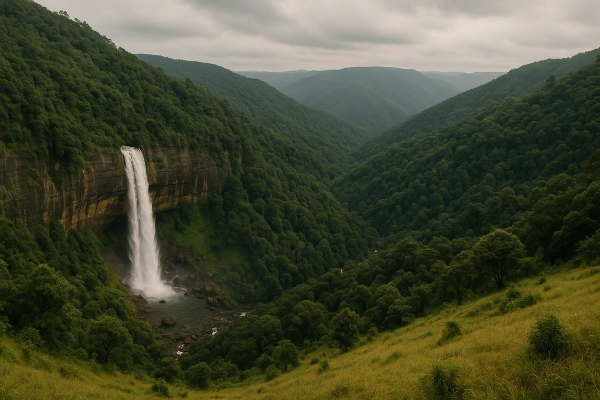Ladakh for All Seasons: When to Visit, What to Do, Weather & Itinerary — from my very real, slightly chaotic trip#
I finally did it. Went to Ladakh, not like a quick photo-dump trip, but properly… with slow mornings, altitude headaches, roadside Maggi at places you can't pronounce, and that one evening when the sky over Leh went cotton-candy pink and quiet. Honestly, I went in thinking I knew what it would be like because, Instagram, but the reality? Harsher, kinder, weirder, and way more beautiful. You know when you feel very small and very awake at the same time? That.¶
When to go — Ladakh in every season (yes, even winter)#
- May–June: Spring flips to summer. Snow still clinging to passes early May, but Leh warms up. Great for first-timers. Fewer crowds than July.
- July–August: Peak season. All roads open, all lakes dramatic blue, also most tourists. Expect higher prices and traffic at Khardung La, Pangong, etc.
- September: My fav. Golden poplars, crisp air, less crowd, clear skies. Good for photos, calmer vibe, slightly cheaper stays.
- October: Stunning but cold. Nights bite. Some camps shut. If you're ok with layers and hot water bottles, you'll love it.
- November–March: Winter Ladakh. Quiet, white, serious cold. Chadar Trek season if the Zanskar freezes properly, and Leh stays open by flight. Not for casual tourists, but magic if you're prepared.
Weather, but like what it actually feels like there#
Daytime in summer can be 15–25°C under a sun that acts like a laser. Shade drops it by 7–10 degrees. Nights go 5–10°C in Leh, sub-zero at Pangong, Hanle, Tso Moriri even in peak months. Wind is a character in Ladakh — sometimes it just slaps your face with dust at 3 pm. UV is brutal; I got raccoon tan even with SPF 50. Winter, it's -10 to -20°C easily and dry. Hydration is a full-time job. Also, altitude isn’t just a Google point — even climbing two flights of stairs can feel like a gym session you didn’t sign up for.¶
Latest travel updates and useful stuff I wish someone told me#
- Network: As of 2025, only postpaid SIMs work in Ladakh. Jio and Airtel okay in Leh, patchy beyond. BSNL survives in random villages. Keep cash because UPI fails outside Leh often.
- Permits: Indians usually need Inner Line Permits for Nubra, Pangong, Turtuk, Hanle, Tso Moriri, Chushul routes. Do it online on the LAHDC Leh site or at the DC office. Pay environment fee, wildlife fee, Red Cross. Foreign nationals need Protected Area Permit via a registered agent.
- Road windows: Srinagar–Leh opens around May, shuts by Oct/Nov depending on snow at Zojila. Manali–Leh typically June to Oct via Baralacha La. Always check BRO updates before driving. Weather can flip plans in one chai break.
- Taxi rules: Outside commercial taxis aren’t allowed for local sightseeing beyond Leh. Hire a Ladakh taxi for circuits. Private cars are fine.
- Hanle Dark Sky Reserve: Go. Just… go. Community-run stargazing nights are a thing now. Dress warm and switch off your car lights please.
- Drones need permits. Don’t launch without asking. Army areas are everywhere. Respect checkposts, don’t argue at 16,000 ft — they win.
Getting there… and getting around without losing your mind#
Flights into Leh are frequent from Delhi, sometimes Mumbai, Chandigarh, Srinagar seasonally. You land and the mountains are just there like a wallpaper someone maxed out resolution on. If you’re driving, Srinagar route is gentler for acclimatization; Manali route is more dramatic but tougher. For moving around: Ladakh taxis are pricey but reliable with fixed union rates. Roughly, local Leh day around 3.5–5k; 2D1N Nubra loop 12–18k; Pangong day return 9–14k; multi-day custom routes negotiable. Bikes? Royal Enfield 350/500 rentals 1200–2000 per day, Himalayan a bit more. Check brakes, carry spare tubes, and don’t be a hero on black ice. Fuel up wherever possible — long stretches have nothing. Self-drive rentals from outside states work if they’re private plate; commercial outstation rentals not allowed for sightseeing beyond Leh.¶
Where to stay and what it’ll cost now#
Leh has everything from old-school guesthouses to cute boutique stays. Ballpark: budget rooms 1200–2000 per night, mid-range 3000–7000, boutique 4500–10k, luxury from 12k+. In Nubra and Pangong, camps and homestays are common — 2500–6000 depending on view and meals. Winter stays with room heating cost more; check if it’s electric blanket, bukhari, or central heating. Power cuts happen, so charge up when you can. I liked homestays best — hot butter tea appears magically and you get real stories, not brochure English.¶
What to do — my favourites, not all obvious#
- Thiksey Monastery sunrise. The Maitreya statue glows, and the morning chants kinda rearrange your head. Wear socks, stone floors are ice.
- Pangong Tso for the colors, yes, but stay a night if you can. The hush at 2 am under absurd stars… yeah.
- Nubra Valley: Hunder sand dunes and the shaggy double-humped Bactrian camels. Do the camel ride if you must, but keep it short and humane.
- Turtuk. Balti village walks, walnut trees, apricot jam, army stories over chai. Felt like the edge of a map.
- River rafting at Sangam in summer. Cold water slaps you awake, then you start whooping like a child. Worth it.
- Alchi and Likir circuit for ancient art. Alchi’s murals are jaw-dropping old — carry a small torch and loads of patience.
- Hanle for stargazing and the absolute silence. Respect light restrictions. If clouds roll in, wait. They usually part.
- Lamayuru Moonland and the long switchbacks. Road snack = Parle-G and salty tea. Don’t ask why it works, it just does.
Lesser-known detours I loved (and you might too)#
- Uleytokpo and Sham Valley homestays — gentler altitude, nice day hikes, apricot orchards.
- Panamik hot springs in Nubra — touristy but lovely on a windy day. Go early.
- Dha–Hanu villages — unique culture, check etiquette and dress modestly. Ask before photos.
- Chilling village — metalworker heritage and base for rafting. In winter it’s properly cinematic.
- Rezang La War Memorial near Chushul — humbling. Roads require correct permits; weather-dependent.
- Tso Kar — salt lake, birdlife. Sparse camps, mad winds, bring layers that fight back.
Food that warmed my soul (and fingers)#
I lived on thukpa, momos, skyu, chutagi, and khambir with butter or apricot jam. Try butter tea once at least — it’s weird until it’s not. Cafes in Leh do solid cappuccinos and pizzas now, but don’t skip simple dal-chawal at homestays. Tibetan Kitchen has that old-school charm, and there are German bakery style places for desserts. Price-wise: local meals 200–350, cafe mains 350–700, coffee 200–350. At high lakes, everything costs more because well, moving a gas cylinder to 14,000 ft is not easy. Carry a thermos; refills save money and plastic.¶
Health and altitude: don’t be a hero, be sensible#
- Acclimatize. Day 1 and 2 in Leh should be slow. No heavy walks, no runs. Nap, hydrate, read a book, watch clouds fight the Stok Kangri ridge.
- Drink 3–4 liters water but sip-sip, not chug. ORS helps. Cut alcohol and ciggies first 48 hours. Your body will thank you later.
- Diamox if your doc says so. I carried it and used a low dose. Also ginger candies for nausea.
- Sunscreen, sunglasses, lip balm. The sun is personal up there. It will find you.
- In case of severe headache, breathlessness, vomiting — descend. Leh hospital is decent. Oxygen cans are stop-gap, not solution.
Itineraries that actually work (and won’t wreck you)#
Classic 6–7 days for first-timers: Day 1 Leh rest, Day 2 Leh local monasteries and permits, Day 3–4 Nubra via Khardung La with Turtuk if roads allow, Day 5 Pangong via Shyok, Day 6 back to Leh via Chang La, Day 7 buffer or Sham Valley. Longer 9–10 days for explorers: Add Tso Moriri and a night in Hanle, or do the Lamayuru–Alchi loop slow. Winter 4–5 days: Base in Leh, do half-day trips to Sangam, Magnetic Hill, monasteries, maybe a frozen-river day walk with a trusted operator if conditions are safe. Keep buffers — mountains don’t care about your calendar.¶
Money talk — what I actually ended up spending#
- Stay: 1500–6000 per room per night depending on comfort and season. I did a mix, averaged ~3000.
- Food: 600–1200 per person per day if you eat out two meals. Cheaper at homestays.
- Transport: Solo it hurt a bit. Shared taxi helps. My 2D1N Nubra was ~14k split three ways. Bike rentals ~1500 per day plus fuel.
- Permits and fees: Around a few hundred per head plus per-day wildlife fee. Keep small notes.
- Extras: Rafting 1500–2500 depending on stretch, stargazing tours vary, souvenir prayer flags 100–200.
Culture, festivals, and not being that tourist#
Dress modest, especially in monasteries; shoulders and knees covered is basic respect. Ask before clicking people. Remove shoes where needed. Hemis Festival in early summer is a vibe — mask dances, drums, whole community out. Ladakh Festival usually in September brings music and polo matches. Don’t litter, don’t pick wildflowers, don’t blast Punjabi bangers at Pangong at midnight. Refuse single-use plastic when you can, refill bottles, and pack your trash out. Also, small thing — learn to say julley. It means hello, thank you, and somehow welcome too. Changes the whole mood of a conversation.¶
Wrapping it up#
If Ladakh is calling, go. But go slow. Respect the altitude, the culture, the army convoys, the old poplar trees, the street dogs sunning themselves at 9 am. The mountains will show you their best when you stop rushing them. If you want more messy, honest travel notes and practical guides, I keep sharing on AllBlogs.in — swing by, say julley, tell me what I missed because, trust me, Ladakh always has another story tucked behind the next bend.¶














